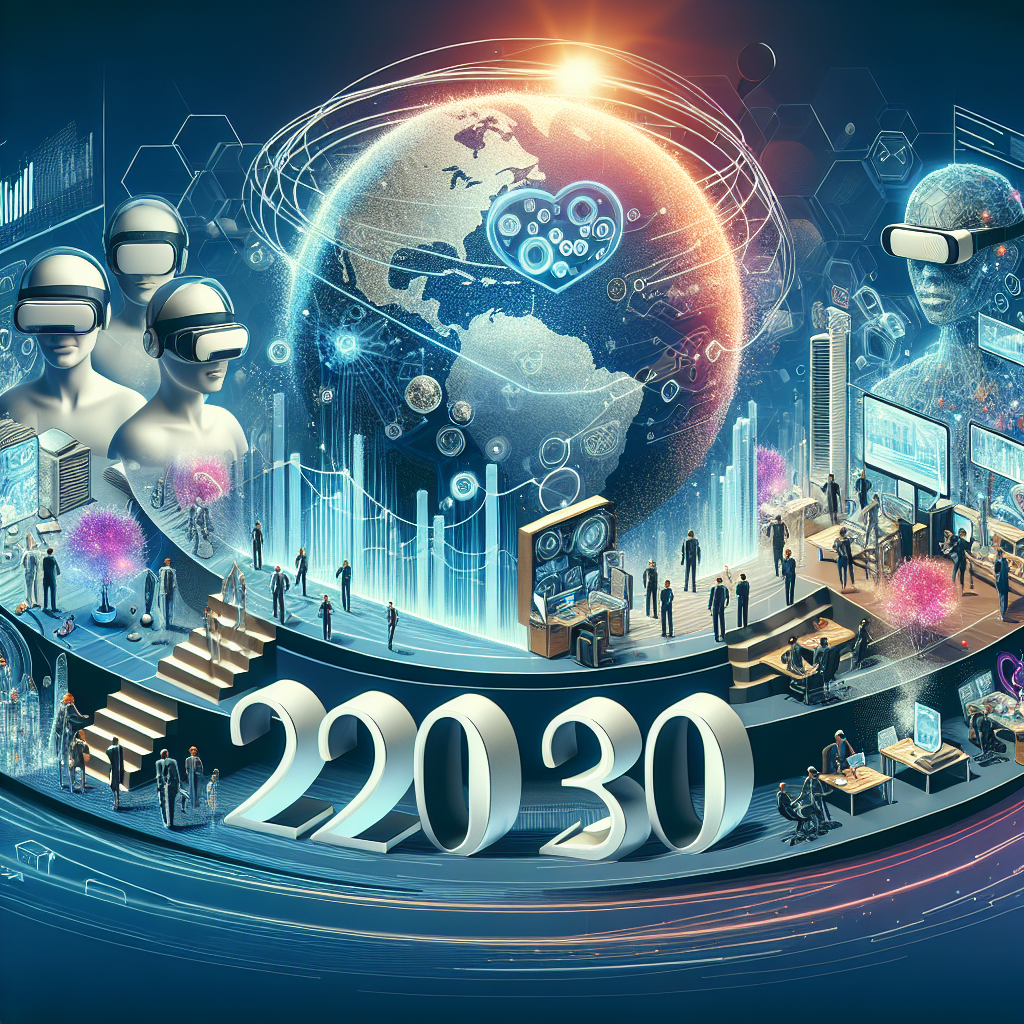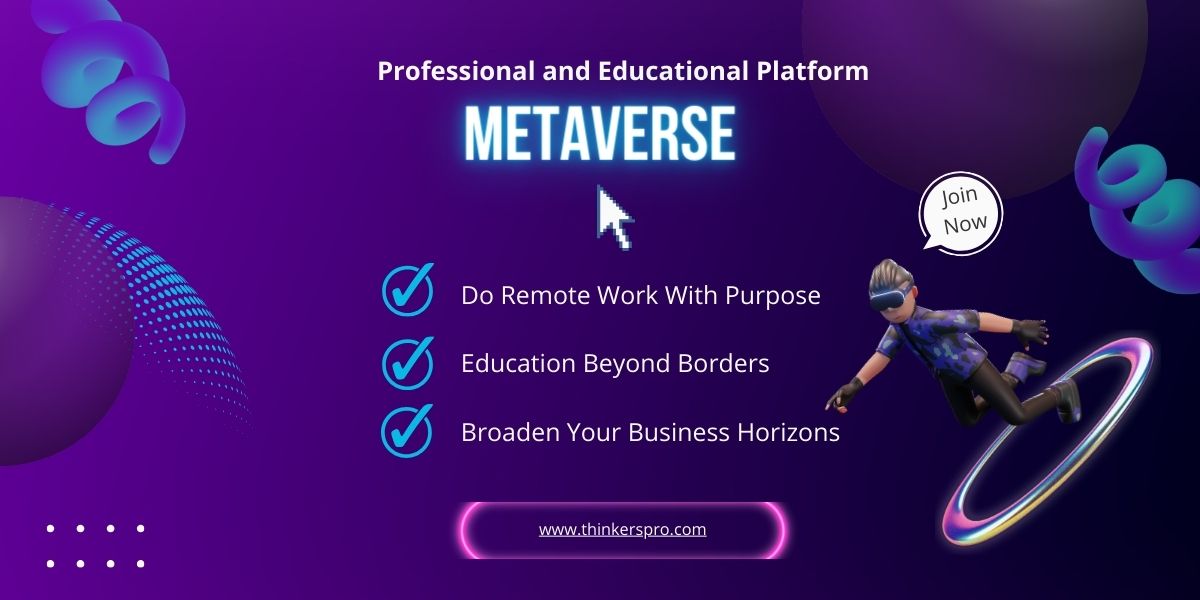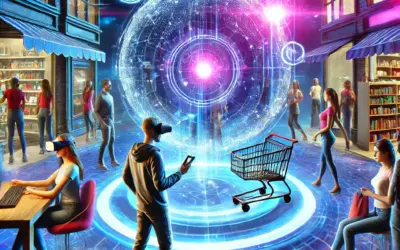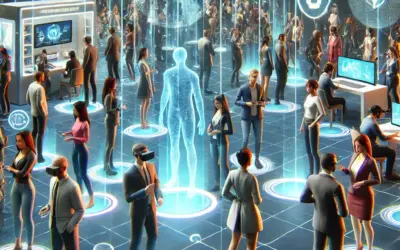Understanding the Metaverse: A Gateway to Business Opportunities in 2030
The concept of the metaverse has been garnering a lot of attention as the next digital frontier where people can work, play, and socialize. This immersive virtual world, which is rapidly evolving, promises a plethora of business opportunities, potentially transforming how industries operate. By 2030, experts predict that the metaverse will have significantly matured, presenting new avenues for entrepreneurs and established businesses to explore innovative marketing, sales, and operational strategies.
Exploring the Economic Potential of the Metaverse
The economic potential of the metaverse is vast, with projections indicating that it could contribute significantly to global GDP. As virtual and augmented realities blend to create seamless experiences, the demand for hardware, software, and content is expected to surge. The metaverse can serve as a marketplace where digital goods and services are traded, mirroring—and in some cases, surpassing—the complexity and productivity of the physical economy. Businesses that understand how to navigate this digital landscape and tap into its unique characteristics will be well-positioned to capitalize on its growth.
Industries ranging from retail to real estate are envisaging their place in the metaverse. Retailers, for example, can create immersive shopping experiences that allow customers to try products virtually before purchasing them. Real estate in the metaverse is not confined by physical limitations, enabling businesses to craft unique virtual spaces that can be leased or sold. As the fidelity of these experiences improves, the line between digital and physical assets will continue to blur, encouraging traditional businesses to integrate metaverse strategies into their models.
Innovative Marketing in the Metaverse
Marketing within the metaverse presents uncharted territory ripe for innovation. Digital billboards, sponsored events, and interactive product demonstrations are only the beginning. In this space, the audience can engage with advertisements in a more interactive way than ever before. Brands can build entire worlds around their products, creating immersive experiences that tell a story more compellingly than static images or videos. As the metaverse’s user base grows, so too does the potential reach of these campaigns. Companies that can harness the storytelling power of the metaverse will have a distinct advantage in captivating and retaining their audience’s attention.
Personalization takes on a new meaning in the metaverse, as user data can be utilized to tailor experiences in real-time. For savvy businesses, this means the ability to offer incredibly targeted promotions and content, resulting in a higher conversion rate. The key to success in metaverse marketing will be balancing personalization with privacy, ensuring users feel secure in their virtual interactions while still receiving a bespoke experience.
Navigating Challenges and Embracing Innovation
While the metaverse presents abundant opportunities, businesses must also be cognizant of the challenges posed by this new domain. The virtual economy’s regulatory landscape is still in its infancy, and companies will need to navigate issues around cybersecurity, data privacy, and digital rights. Moreover, ensuring accessibility and inclusivity within the metaverse will be crucial for businesses looking to build sustainable and responsible platforms that can thrive in the long term.
Technology and innovation will be at the core of the metaverse’s infrastructure. Harnessing advancements in artificial intelligence, blockchain, and 3D modeling, businesses can create autonomous, secure, and complex environments. Those that invest in these technologies early, adapting their operations and workforce to the metaverse, will stand at the forefront of this digital renaissance. It’s an environment that rewards creativity and bold moves, and the metaverse is bound to evolve in ways we are yet to imagine.
In conclusion, the metaverse is not merely a gaming platform or social media trend; it’s a burgeoning ecosystem where the digital and physical converge to create unparalleled opportunities. Businesses that equip themselves with the right tools and expertise to navigate this space will find a wide array of potential in the realm of virtual economies, marketing, real estate, and beyond. The year 2030 is poised to be a pivotal point in the evolution of the metaverse, and understanding its nuances now can set the groundwork for substantial business growth in the digital frontier.
Emerging Industries: The Vanguard of Metaverse Innovation by 2030
As we approach the year 2030, the Metaverse is rapidly transitioning from a science fiction concept to a tangible ecosystem that intermingles with various aspects of our daily lives. The integration of virtual and augmented reality has given rise to a new frontier of industries poised to lead the charge in Metaverse innovation. This article explores key sectors that are not simply adapting to the Metaverse but are driving its evolution, with insights into how they are reshaping both the digital landscape and the physical world.
Virtual Reality (VR) and Augmented Reality (AR) Development
VR and AR are the pillars of the Metaverse, offering immersive experiences that go beyond traditional media. By 2030, these technologies will have matured significantly, leading to more seamless and interactive virtual environments. Development in this sector includes advanced VR headsets with enhanced sensory features and AR tools integrated into everyday life, revolutionizing the way we work, learn, and play. Investments in VR and AR development are fueling the rapid growth of the Metaverse’s infrastructure, laying the groundwork for an interconnected virtual society.
Blockchain and Cryptocurrency Integration
Blockchain technology and cryptocurrencies form the backbone of Metaverse economy, enabling secure and transparent transactions. As we move towards 2030, we can expect these technologies to become more intertwined with the Metaverse, facilitating activities like asset purchases, digital identity verification, and the creation of decentralized autonomous organizations (DAOs). The convergence of blockchain with Metaverse innovation is not only expanding the scope of virtual commerce but is also introducing new models for ownership and investment in digital spaces.
Social Connectivity and Collaboration Platforms
As the Metaverse grows, so does its potential for social connectivity. Emerging collaborative platforms are expected to revolutionize how we interact socially and professionally by 2030. A surge in digital meeting spaces and virtual communities offers unprecedented opportunities for networking, collaboration, and socialization. By then, the thin line between social media and the Metaverse will have blurred, with users experiencing fully-fledged life-like interactions in a multitude of virtual settings.
- Educational and Training Simulations
- Virtual Tourism and Real Estate
- Entertainment and Media Evolution
- Cybersecurity and Data Privacy Measures
The intersection of these industries is setting the stage for a holistic Metaverse ecosystem that is rich with opportunities and potential for innovation. As we journey through the decade, monitoring the evolution of these leading-edge sectors will be critical for anyone looking to understand the trajectory of technological advancement and its impact on society.
Strategic Investment Tips for Capitalizing on the 2030 Metaverse Economy
The metaverse is no longer a fragment of science fiction; it is becoming a substantial component of the global economy. As we approach 2030, investors would do well to consider the metaverse, not merely as a trend, but as a growing digital ecosystem that could redefine how people interact, work, and play. To capitalize on the burgeoning 2030 metaverse economy, strategic investment requires a keen insight into what sectors within this digital frontier are poised for growth and how to prudently allocate resources to reap long-term benefits.
Understanding the Metaverse Infrastructure
First and foremost, the infrastructure of the metaverse is a crucial foundation for all its functions and services. At its core, the infrastructure encompasses the hardware, such as virtual reality (VR) headsets and sensors, and the software, which includes the platforms and tools for creating digital environments and experiences. Investing in the companies that lead in these areas could be immensely profitable as demand continues to ramp up. This also includes businesses focusing on improving connectivity through 5G and beyond, ensuring a seamless and immersive user experience.
Additionally, consider the underlying technologies such as blockchain, which enables secure transactions and creates a backbone for digital ownership and asset transfer—a concept that is revolutionizing ownership in the digital space. Companies that leverage blockchain to build trust and facilitate commerce in the metaverse could stand out as pivotal players in the market. Moreover, the need for robust cybersecurity solutions in the metaverse opens up another avenue for strategic investment.
Targeting Emerging Metaverse Platforms and Virtual Real Estate
As you position your portfolio for 2030, targeting emerging platforms within the metaverse is akin to capitalizing on the early days of the internet. These platforms are the virtual «land» upon which experiences are built. Investing in virtual real estate, particularly in burgeoning virtual worlds, could equate to owning premium, high-traffic city blocks in the physical world. With an increase in users, these virtual spaces become venues for advertising, social gatherings, and e-commerce, driving up their inherent value.
Moreover, the role of non-fungible tokens (NFTs) in representing ownership of digital assets within these platforms can’t be overstated. While investing in NFTs themselves can be volatile, putting your money into the marketplaces and technologies that facilitate NFT transactions may provide a more stable way to gain exposure to this booming segment of the metaverse economy.
Capitalizing on Metaverse Content Creation and Experiences
Another critical aspect of the metaverse upon which investors should focus is content creation and the experiences that define it. The metaverse opens up expansive opportunities for entertainment, education, and socialization. Investment in businesses that excel in creating immersive, engaging, and interactive content could yield substantial returns as content is what keeps users returning to the metaverse. This includes investments in game development studios, educational technology firms, and companies driving innovations in digital events and conventions.
Venturing beyond entertainment, the metaverse is also carving out a significant niche in professional applications. Virtual training and simulation software are gaining traction across numerous industries, from healthcare to aerospace. These applications offer enormous potential for investors interested in tapping into the intersection of technology and practical, scalable solutions.
In conclusion, the insights provided herein lay out the numerous opportunities within the metaverse for investors aiming to capitalize on what is shaping up to be a transformative period in our digital history. Strategic investment in infrastructure, emerging platforms, virtual real estate, content creation, and professional applications within the metaverse presents a diverse array of avenues to potentially benefit from the 2030 metaverse economy.
The Blueprint for Building Your Business in the Metaverse of 2030
Entering the Metaverse in 2030 requires a strategic approach, blending cutting-edge technology with innovative business practices. To thrive within these vast virtual ecosystems, companies must adapt and evolve, ready to meet the unique challenges and harness the boundless opportunities of digital environments. A compelling blueprint for building your business in the future’s Metaverse starts with understanding the platform’s core components and the audience it attracts.
Firstly, it’s essential to comprehend the Metaverse’s infrastructure—a complex network built on blockchain technology, augmented reality (AR), virtual reality (VR), and artificial intelligence (AI). Businesses need to invest in robust IT systems capable of supporting high-quality, immersive experiences that users demand in virtual spaces. Moreover, with decentralization being a key attribute of the Metaverse, embracing blockchain provides transparency and security, fortifying user trust and fostering a sense of community.
Identifying Your Niche in the Metaverse
With an expansive range of possibilities, identifying your niche is critical. Whether it’s virtual real estate, digital fashion, or e-sports, businesses must pinpoint areas where they can provide unique value. Assess your core competencies and align them with emergent Metaverse demands. Savvy entrepreneurs will capitalize on trends and gaps in the market, setting a solid foundation for growth and innovation. Customizing user experiences to specific interests can not only boost engagement but also build a loyal customer base in a competitive virtual landscape.
Developing an Engaging Virtual Presence
Your virtual presence is your brand’s essence in the Metaverse. It should resonate with virtual communities and represent your values and mission. Creating an engaging and interactive space that encourages exploration and social interaction is key. Building an environment where users can test products, attend events, or simply socialize will attract a diverse audience and keep them coming back. Virtual presence isn’t just about appearances; it’s also about utility and providing a seamless and enriching user experience.
- Customize virtual storefronts to reflect brand identity
- Offer unique virtual experiences to engage users
- Utilize AR and VR to enhance the customer experience
As you craft the blueprint for your Metaverse business, assessing the competitive landscape is crucial. Identify key players, innovative startups, and potential partners or competitors. Understanding market dynamics, including customer preferences and competitor strategies, will help you refine your business model for success in a continually evolving digital realm.
Networking in the Metaverse: Collaborative Opportunities to Look for in 2030
As we usher in a new decade, the concept of networking has transcended physical boundaries, thanks to the ever-evolving Metaverse. The digital landscape is ripe with unique possibilities for collaboration, enabling professionals to connect and co-create like never before. One may wonder what collaborative opportunities wait in the wings of this virtual frontier. With technology shaping the way we interact, 2030 manifests as a pivotal year for those invested in leveraging the Metaverse for networking.
Virtual Meetups: Redefining Professional Conferences
The notion of attending conferences in the Metaverse is not a distant reality; it’s here and will become even more engrained in professional networking by 2030. Virtual meetups enable participants to engage with thought leaders, innovators, and peers from across the globe, sans the limitations of geographical constraints. These events often showcase immersive presentation experiences, featuring interactive 3D models and live simulations that provide a deeper level of engagement compared to traditional webinars or teleconferences.
Industry exhibitions in the Metaverse can also foster remarkable networking avenues, as avatars navigate virtual booths, exploring cutting-edge products and technologies. Tailored networking lounges offer real-time voice and text communication, promoting collaborations that can blossom into meaningful business partnerships. Experts forecast that by 2030, these virtual spaces will be further enriched with artificial intelligence (AI) matchmaking algorithms, designed to connect professionals based on mutual interests, industry relevance, and potential synergies.
Collaboration in Digital Workspaces
As we project into 2030, digital workspaces in the Metaverse will have matured into sophisticated platforms for collaboration. These spaces simulate the experience of working side-by-side with colleagues, transcending the limitations of remote work. Virtual reality (VR) will offer tools for intuitive interaction with digital assets, from manipulating data visualizations to constructing complex virtual prototypes. The ability to collaborate within the same virtual space, regardless of physical location, inherently transforms teamwork dynamics, making processes more efficient and inclusive.
Hybrid models of employment will likely be the norm, blending in-office work with Metaverse interactions. Here, employees can switch between realities, combining the best of both worlds to maximize productivity and social interaction. This integration will also give rise to new forms of collaboration, such as co-creation sessions where teams might brainstorm, design, and refine their work in real-time within a virtual setting, fostering an atmosphere of creative synergy that physical spaces may struggle to replicate.
Networking Boosted by Augmented Reality (AR)
Augmented reality (AR) is another pillar of the Metaverse expected to significantly enhance networking possibilities by 2030. While AR may be more grounded in our physical reality, it serves as a bridge to richer, more contextually relevant interactions. Imagine networking where business cards and resumes are dynamic, pulsing with animations and personal branding when viewed through AR smart glasses. Such advances promise to make first impressions even more striking and memorable.
The convergence of AR with geolocation technologies paves the way for location-based networking, where professionals can discover potential collaborators merely by their proximity and shared virtual interests. Imagine arriving at a co-working space and instantly receiving recommendations of like-minded professionals nearby. AR in the Metaverse could make this a daily convenience, intuitively streamlining the process of forming new professional connections.
Conclusion
In sum, as the Metaverse continues to grow and become more integrated with our daily professional lives, networking opportunities in 2030 are likely to be more diverse, interactive, and rewarding than ever. The Metaverse breaks down traditional barriers, making it a powerful tool for building and nurturing professional relationships. While challenges remain in ensuring these spaces are inclusive, secure, and effectively moderated, the potential for enhanced collaboration and networking is vast, limited only by the creativity of its users and the pace of technological advancements.













0 comentarios